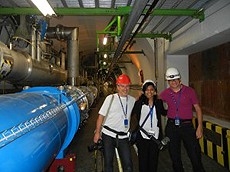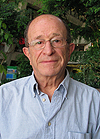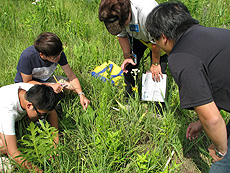|
Have a safe day!
Friday, July 13
3:30 p.m.
DIRECTOR'S COFFEE BREAK - 2nd Flr X-Over
4 p.m.
Joint Experimental-Theoretical Physics Seminar - One West
Speaker: Meenakshi Narain, Brown University
Title: New CMS Results at ICHEP
Saturday, July 14
8 p.m.
Fermilab Arts Series - Auditorium
Red Stick Ramblers
Monday, July 16
2 p.m.
LHC Physics Center Topic of the Week Seminar - Sunrise, WH11NE
Speaker: Daniel Elvira
Title: SUSY Searches II: Elements of a Data Analysis and Their Integration in a Search Result
PARTICLE ASTROPHYSICS SEMINARS WILL RESUME IN THE FALL
3:30 p.m.
DIRECTOR'S COFFEE BREAK - 2nd Flr X-Over
THERE WILL BE NO ALL EXPERIMENTERS' MEETING THIS WEEK
Click here for NALCAL,
a weekly calendar with links to additional information.
Upcoming conferences |
|
Friday, July 13
- Breakfast: Chorizo burrito
- Old-fashioned ham & bean soup
- Philly-style chicken
- Chicken pot pie
- Smart cuisine: Baked fish over rice
- Roasted veggie and provolone panini
- Assorted sliced pizza
- Carved baked ham
Wilson Hall Cafe Menu
|
|
Friday, July 13
Dinner
- Insalata caprese on a skewer
- Stuffed flank steak
- Balsamic roasted potatoes
- Chocolate-amaretto soufflé
Wednesday, July 18
Lunch
- Chicken luncheon salad
- Sorbet
Chez Leon Menu
Call x3524 to make your reservation.
|
|
Google Science Fair winner visits CERN during Higgs week
 |
| Shree Bose, center, visited the LHC tunnel at CERN. Photo: Shree Bose |
Editor's note: Fermilab Deputy Director Young-Kee Kim will be a judge at this year's Google Science Fair on July 21. One of the prizes is a visit to Fermilab and CERN.
Google Science Fair winner Shree Bose could not have picked a better time to visit CERN.
Judges chose Bose as the top young scientist among more than 10,000 submissions from 13- to 18-year-old students all over the world. Part of her grand prize package was a trip to the laboratory on the border of France and Switzerland. She was there from June 27 to July 4, the day scientists there announced the discovery of a Higgs-like boson.
"I was watching history be made," Bose said. She was in attendance for the seminar and saw the results presented in person.
"After that, getting to be at the press conference and see all of these major media outlets reporting to the world what was happening at CERN was just so encouraging," she said. "And I was there."
It was the icing on the cake. During the lead-up to the announcement, Bose spent the week learning about the experiments at CERN and how the Large Hadron Collider works.
"I've learned more about physics in the past few days than in my entire life," Bose said. "But my favorite part is learning about the group effort behind the experiments. One human mind is amazing, but all of these people working together? They can do the impossible."
Bose has quite the mind herself. She was conducting cutting-edge cancer research before she was legally allowed to vote.
For her Google Science Fair project, Bose discovered a specific enzyme was linked to ovarian cancer cells' developing a resistance to certain chemotherapeutic drugs. She also found a way to counteract this effect. She did the research the summer before her junior year of high school.
Bose said that she used to be much more interested in the arts than science, but her brother piqued her interest in the subject.
"My older brother was the science kid," Bose said. After school, Bose's brother would tell her about everything he had learned that day.
"I was about 6 when he tried to explain atoms to me," she said. "He said that if you keep breaking things down, eventually you'd get atoms. I loved that. It explained the world, but also maintained its beauty."
Read more
—Ashley WennersHerron
|
Carlos Hojvat retires after 35 years
 |
Carlos Hojvat
|
Carlos Hojvat first worked at Fermilab as a Research Associate at McGill University in Montreal, Canada, working on a large-momentum-transfer proton-proton scattering experiment in the Proton Area at a time when rubber boots were mandatory. He joined Fermilab on January 1, 1977, as a full-time employee and a member of the Accelerator Division. He also held positions in the Research Division, the Director's Office and more recently in the Experimental Physics Projects group of the Particle Physics Division. He retires today.
Hojvat's first project was the negative hydrogen multi-turn injection for the Booster accelerator, which allowed record beam intensities and the development of the very thin stripping foils. Reporting to then-Director Leon Lederman, he worked on understanding the relationship between the superconducting Tevatron magnets' thermal cycles and the instability of the magnetic field direction. This opened the way to the invention of the famous "smart bolts." He headed the group that designed and built the antiproton target station and its large-current lithium collecting lens as part of the Tevatron I Project. At the Tevatron, Hojvat collaborated on a search for quark-gluon plasma at the C0 intersection region.
In late 1992, Director John Peoples appointed Hojvat to assist with budget planning and negotiating memoranda of understanding with experimental groups. He was also responsible for test beam facilities for experiments at the eventually canceled Superconducting Super Collider.
In 1996, Hojvat became deputy project manager of the Pierre Auger Observatory, a project established to search for the origin of the highest-energy cosmic rays. He set up the administrative infrastructure for the observatory and hired personnel at the site in Mendoza, Argentina. He also formed the Fundación Observatorio Pierre Auger Argentina as the local legal entity to manage the financial and administrative details for operating the observatory. He also collaborated with the local municipality to establish the first digital planetarium in Argentina. Now fully operational and host to several educational programs, it has a full schedule of visits by schools from as far away as Buenos Aires and Chile. In addition, Hojvat helped produce educational videos related to the goals of the observatory.
After retirement, he will continue his responsibilities as president of the foundation, spend time with and enjoy his grandchildren and do a little fly fishing.
|
DOE user facilities praised at House Science Committee hearing
From FYI: The AIP Bulletin of Science Policy News, July 12, 2012
A June 21 hearing of the House Science, Space, and Technology's Subcommittee on Energy and Environment demonstrated strong support for the Department of Energy's user facilities on both sides of the witness table and both ends of the dais. Republicans and Democrats were alike in their praise for the facilities, with the clearest policy differences between them centering on the federal government's role in supporting applied research.
The subcommittee met for about ninety minutes, hearing from three senior user facility officials and two top officials from corporations. Similar to the day-to-day cooperative arrangements that the witnesses described at these facilities, there was little or no dissention among the witnesses, a somewhat uncommon occurrence.
A subcommittee briefing document explained that the DOE Office of Science requested $4.9 billion for FY 2013. Of that, 47 percent was for the "selection and management of research," 38 percent for "operation of world-class, state-of-the-art scientific facilities," and 14 percent for new facilities' construction. The Office's six programs support 31 user facilities, and it is estimated that 26,500 academic, national laboratory, industrial, and international researchers will use these facilities in FY 2013.
Read more
|
|
Coping with high luminosity
 |
| A "Where's Waldo?" snapshot typifies the situation in a high-luminosity, high-interaction environment. If these people arrived one at a time, were separated by larger distances or were more distinct, we could see them more easily. Similarly, scientists have to clarify the particle collision picture to cope with high luminosity. |
Read the expanded column on coping with high luminosity.
After reading a recent Nutshell article about the Intensity Frontier, an inquisitive reader wanted to learn about how we cope with very bright beams. After all, the point of lots of luminosity is to make more collisions to find rare things, but lots of simultaneous collisions can make for a very confusing environment. This is an excellent question and there are many answers. Let's talk about some of them.
For Intensity Frontier experiments, the probability of an interaction is really, really small. This is the case with neutrino physics.
But in the LHC, collisions are frantic. The beams will cross about 40 million times a second when the machine is operating in the final configuration. Each one of those 40 million crossings, or collisions, will give rise to 20 interactions at design luminosity. That comes to nearly a billion interactions per second. At that rate, the detector and electronics are barely coping. Scientists have to come up with some interesting tricks.
The first trick is called a trigger, a smart, automated way to select which of the tens of millions of beam crossings that occur every second are worth looking at—and only a tiny fraction are. The LHC data acquisition system can record about one event for every 100,000 times the beams pass through one another. With triggering, we teach our electronics and computers to recognize the interesting configurations at superhuman speeds. By rejecting uninteresting events and concentrating on the rare, we enhance our chances of observing something that will improve our understanding of the universe.
Just as very few beam crossings are interesting, very few interactions in those beam crossings are interesting. When a detector records one interesting interaction, it simultaneously records on average 19 uninteresting ones, much as an ordinary photograph of a good friend might include pictures of others in the crowd. Again, we have to come up with ways to deal with the information that obscures the interesting events.
One technique is to change how the beams arrive in the detector. Recall that every time the beams cross, or collide, only a tiny fraction of the particles within the beams interact. Currently, the LHC is operating with collisions 20 million times a second. With some additional work, it will be possible to operate with collisions at 40 million times a second. But that doesn't mean we double the amount of beam in the accelerator. Instead, we'll keep the same amount of beam, thus halving the number of interactions that occur at every crossing. This greatly simplifies how we reconstruct the interactions in an event.
We also cope by making detectors with tiny pieces. If the pieces are large, it is possible that two or more particles will cross that particular piece at the same time. By increasing the number of pieces, it's more likely that each piece will have but one particle crossing it.
We see that in many cases, not only does extra luminosity bring new capabilities, it also brings many complex challenges. By making use of automated event selection and building more finely grained detectors, we can fully exploit the benefits of the higher luminosity.
In any case, more data, cleverly studied, is always a good thing.
—Don Lincoln
|
Quadrat study volunteers inspect plots of the prairie
 |
On Thursday, docent Mary Jo Murphy showed a rattlesnake master plant to quadrat study volunteers Imi Cheng and two family members visiting from Taiwan. Another public quadrat study will take place on July 28. A special study for Fermilab employees will take place on August 16. For more information, contact Sue Sheehan at (630) 840-5058. Photo: Joseph Piergrossi |
|
Neutrino physics: Beta test
From Nature, July 11, 2012
Once every 10 trillion trillion years or so, certain atomic nuclei might just break the rules. As two of their neutrons undergo an otherwise normal decay, changing into protons and spitting out electrons, they might fail to release the normal by-products: ghostly particles called neutrinos.
To have any chance of detecting this rare 'neutrino-less double-β decay', physicists have to collect a few trillion trillion atoms of an appropriate isotope — tens or even hundreds of kilograms' worth — put their sample deep underground so that it is isolated from cosmic rays and conventional radioactivity, then spend years counting potential decay events until they are sure that any signals they see aren't noise. It is an intricate and painstaking process, but several collaborations around the world are doing it, and some could even come up with an answer by the end of the year.
Read more
|
|